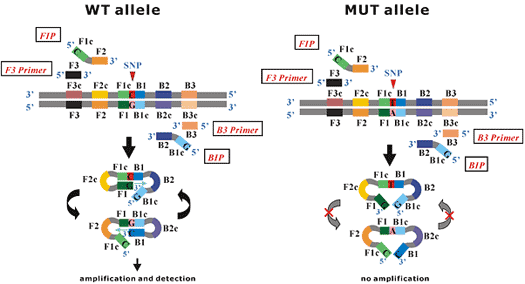- TOP
- About LAMP
- SNPs typing
SNPs typing
LAMP-based SNPs typing
Because of the high specificity of the LAMP method, only the target gene will be amplified from gene samples containing homologous nucleotide sequences when using LAMP-based SNPs typing. Furthermore, because of the characteristics of its amplification reaction (c.f. basic principle), the LAMP method discriminates a single nucleotide difference at each cycling step of the DNA replication, through both "sense and anti-sense strand" reactions, and the type of SNP can easily be detected just by amplifying the DNA containing SNP in a single step.
Due to the simplicity and rapidity of the LAMP method, simple detection of SNPs typing can be achieved within 30 minutes.
Characteristics
- With the use of 4 primers designed to recognize 6 distinct regions, only the target gene is strictly and specifically amplified even in coexistence with its homologous gene.
- The reaction is so specific as to strictly discriminate single nucleotide difference.
- The SNPs typing can be achieved by detecting the presence of amplified products in a single step.
Basic principle
The figures below show the basic principles of the process when using Wild Type (WT) Primers.
The FIP and BIP are designed to contain a SNP nucleotide (in this case of Wild Type allele) at 5' end, respectively.
Using the WT primers, when the target gene is the WT allele, DNA synthesis from dumbbell-like starting structure proceeds and the LAMP amplification cycling continues.
In contrast, when the target gene is the Mutant (MUT) allele, no DNA synthesis proceeds from dumbbell-like structure and the LAMP amplification cycling dose not occur. Even if DNA synthesis proceeds in one step due to miscopy, the amplification reaction is either halted in other steps or is delayed since repetition of this reaction continually checks at each cycling step of the DNA replication.
